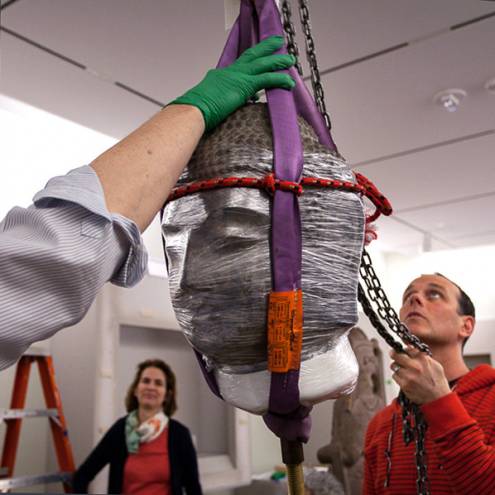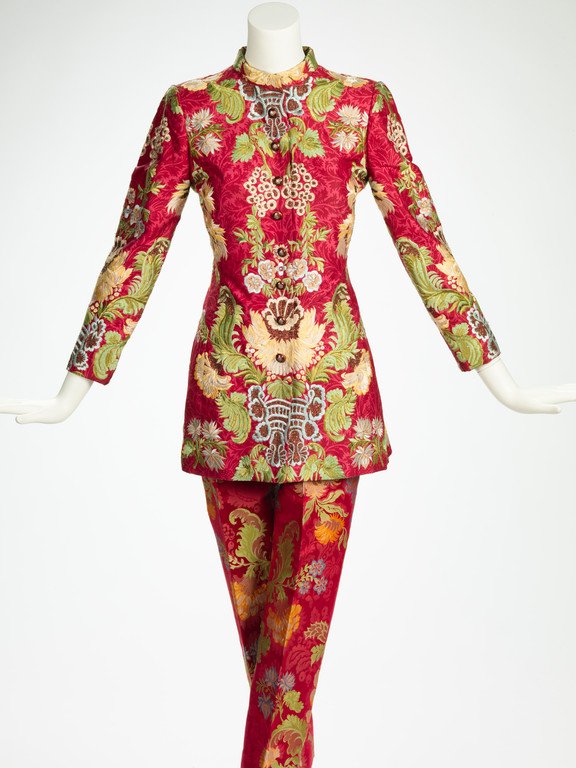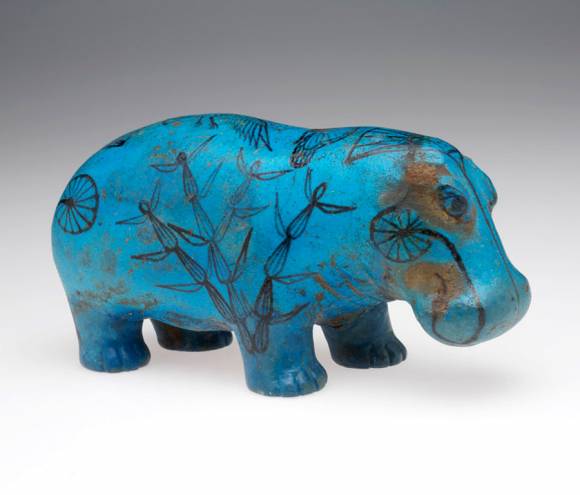









How much do you think a RISD education costs? $100,000? $150,000? More? Try $12.
At that level, you might not walk out with a degree or the right to call yourself a classically trained artiste, but you can learn a thing or two.
Twelve dollars is the cost of a regular adult admission at the RISD Museum (and there are even cheaper options), where the recently completed Radeke Restoration Project has reinvented the sixth floor.
 By now, you may have heard about the extensive renovations – and they’re admittedly pretty cool. The Eliza G. Radeke Building, dating to 1926, is the core structure of the museum’s five buildings, and is listed on the National Register of Historic Places. In 2006, the museum embarked on an $8.4 million renovation that addressed three public floors of galleries and teaching spaces in four phases. The completed work was unveiled on June 13, and the centerpiece of it is the restoration and reinvention of the sixth-floor galleries housing the museum’s collections of Egyptian and Asian art (two of its most popular), and costume and textiles (which have been tragically underexplored).
By now, you may have heard about the extensive renovations – and they’re admittedly pretty cool. The Eliza G. Radeke Building, dating to 1926, is the core structure of the museum’s five buildings, and is listed on the National Register of Historic Places. In 2006, the museum embarked on an $8.4 million renovation that addressed three public floors of galleries and teaching spaces in four phases. The completed work was unveiled on June 13, and the centerpiece of it is the restoration and reinvention of the sixth-floor galleries housing the museum’s collections of Egyptian and Asian art (two of its most popular), and costume and textiles (which have been tragically underexplored).
There is a lot to like about these renovations. The RISD Museum is known for having impressive and deep costume and textile collections – in fact, they were some of the first items in the museum’s collection – yet the Radeke Restoration represents the first time these treasures have their own dedicated spaces. Costume and Textile Curator Kate Irvin shows me a piece of Filipino piña cloth, made in the mid-19th century from a pineapple leaf fiber. “This has been in the museum since 1914, but it’s probably never been displayed before now,” she notes.
In addition to the new textile gallery, there is also the Donghia Costume and Textiles Study Center. Students and visitors can go on a self-guided exploration of a rotating series of work displayed in more than 20 large study drawers. iPads offer information and closer examination of the individual items. “We want the public to explore on their own,” says Irvin. “We’ve reached into the depths of our collection.” To that end, these drawers, along with many of the other exhibits in the new galleries, will be rotated every six months.
Beyond the new new features on the sixth floor, what’s old is also new again – namely the museum’s two most popular exhibits: the Buddha and the mummy. The big man is finally ready for his close-up, with softer, more natural light (part of which emanates from a formerly bricked over window that was reopened during renovations) around his new freestanding pedestal. The museum has had the giant wooden statue since the 1930s, but as Museum Publicist Lani Stack notes, “This is the first chance we’ve really had to take a close look at him and see what he has to say.” In studying and documenting the work, conservator Ingrid Neuman discovered three painted Japanese inscriptions, the legible parts of which have been translated for the new display.
 Meanwhile, our old friend Nesmin, the Egyptian priest (you remember him from your school field trip, right?), now rests in a swanky, custom-designed display. The tiered mountings allow visitors to simultaneously examine the mummy himself, the coffin’s exterior and the previously hidden interior with the paintings he would have looked at in the afterlife. “It’s not something most museums would show you,” Stack points out. They even brought the mummy down to a lower level so that kids can more easily have a look on those school field trips.
Meanwhile, our old friend Nesmin, the Egyptian priest (you remember him from your school field trip, right?), now rests in a swanky, custom-designed display. The tiered mountings allow visitors to simultaneously examine the mummy himself, the coffin’s exterior and the previously hidden interior with the paintings he would have looked at in the afterlife. “It’s not something most museums would show you,” Stack points out. They even brought the mummy down to a lower level so that kids can more easily have a look on those school field trips.
There are plenty of other cool architectural and technological improvements, as well: a recently uncovered skylight over the south staircase; better lighting to improve views and better acoustic baffles to improve the sense of serenity; wi-fi access; and Channel: an audio program that offers a deeper exploration of the making of many items.
This is where the renovation becomes truly something different. The galleries haven’t just been remodeled – they’ve been reimagined. With that reimagining comes a whole new approach to how exhibits are curated, how collections are explored and how items are displayed. “The most commonly heard reaction at the museum is, ‘Wow, how did they do that?’” says Education Director Sarah Ganz. “We’re responding to that with the fact that we’re an art school.”
Indeed, much of the focus across the galleries is on exploring the processes and motivations behind the works of art. This extends to many subtle details in the way that objects are displayed and pieces within the exhibits are arranged. Items are often grouped thematically, crossing eras and cultures to show the development of ideas and techniques. “We can show interactions and juxtapositions between old and new. You can get lost in it,” says Irvin.
As an example, she takes me to the new textile gallery, where a collection of printed cottons bearing botanical motifs fills a glass case. “We wanted the first installation to be very dense and show the diversity of the collection,” she explains. The items span different countries and time periods, demonstrating how one culture informs and influences another. Beginning with a contemporary piece made by a Japanese designer from a classic British fabric, the exhibit traces the influence back to an Indian mat for a Muslim market, up through a jacket made in Persia sometime between 1850-1900, over to a French print very much influenced by the Indian one, back to the 1790s with a dress made in London by an Irish printer and into another British textile length from the mid- to late-1800s. Irvin’s guided tour jumps and jaunts from one to another, creating what she calls, “cross cultural narratives.” “We haven’t been able to tell these stories in this way before,” she adds. “We’ve done it in classes, but now we can do it in public.”
The Donghia Study Center offers the same sorts of juxtaposed narratives. Irvin pulls open a single drawer to reveal a child’s tunic from Egypt, mittens from Sweden, fabrics and garments spanning Africa, South America, Persia and more. The unifying thread (if you’ll pardon the pun) is that they are all examples of pile textiles, which the viewer could learn from the nearby iPad.
 Beyond creating cross-cultural narratives, the reimagining of the Radeke galleries allows the museum to take an educational approach to displaying works of art. Objects are chosen and displayed in such a way as to reveal the techniques and motivations of the artists behind them, as well as their purpose and function in their respective cultures. Indeed, some pieces aren’t works of art at all, but teaching tools. Stack points out an ancient Egyptian piece, Sculptor’s Model of a Woman, dating to 332-30 BCE. It’s a fragment of a piece really, but she shows me around the back (which is revealed in the new display cases) and points out the grid carved into it. She explains that this piece was a model used by a sculptor to teach students the “Egyptian canon of proportions,” and that the grid was intended to show scale. The nearby Sculptor’s Model of a Striding King served a similar purpose.
Beyond creating cross-cultural narratives, the reimagining of the Radeke galleries allows the museum to take an educational approach to displaying works of art. Objects are chosen and displayed in such a way as to reveal the techniques and motivations of the artists behind them, as well as their purpose and function in their respective cultures. Indeed, some pieces aren’t works of art at all, but teaching tools. Stack points out an ancient Egyptian piece, Sculptor’s Model of a Woman, dating to 332-30 BCE. It’s a fragment of a piece really, but she shows me around the back (which is revealed in the new display cases) and points out the grid carved into it. She explains that this piece was a model used by a sculptor to teach students the “Egyptian canon of proportions,” and that the grid was intended to show scale. The nearby Sculptor’s Model of a Striding King served a similar purpose.
Stack, a dancer herself, then takes me to view Shiva Nataraja, the King of Dance, a 16th century Indian statue. It is displayed on a freestanding pillar in the middle of the room, instead of being mounted against a wall. New research by the museum revealed that this piece was intended to be carried in processions, hence displaying it in the round, so that the viewer can observe it the way it was meant to be seen. She even points out the hole in the statue where a pole would have been inserted to carry it in the procession.
“These are just bits and pieces,” Stack explains. “We quite deliberately made it so you see them as fragments. What does the object itself propose, as opposed to what do we want to say overall?”
Expanding on this sense of art education, Channel, the new audio program, brings the artist’s voice into the galleries in a way it never has been present before. In over 100 commentaries, artists and scholars were brought in to explain, examine, interpret and reveal the secrets behind select pieces. For instance, Shiva Nataraja’s audio includes commentary from both a dancer and a religious studies scholar from Brown, exploring both facets of the piece.
It’s a great education on how and why art is really made, something you might not get from a museum that’s not attached to an art school. And all for only $12, making it the best deal in art education.
RISD Museum. 224 Benefit Street. 454-6500
Comments
No comments on this item Please log in to comment by clicking here